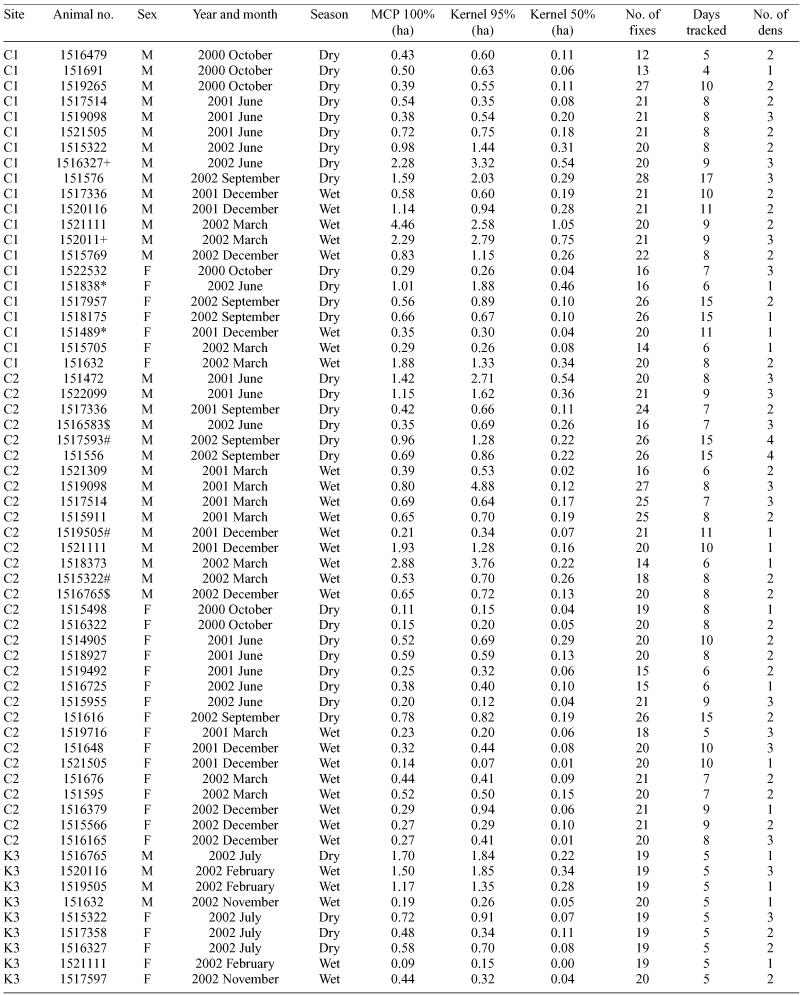Home range and den characteristics of the brush-tailed rabbit-rat (Conilurus penicillatus) in the monsoonal tropics of the Northern Territory, Australia
Ronald S. C. Firth A D , John C. Z. Woinarski B and Richard A. Noske CA School of Science and Primary Industries, Charles Darwin University, and CRC for Tropical Savannas Management, Darwin, NT 0909, Australia.
B Biodiversity Conservation, Department of Natural Resources, Environment and the Arts, PO Box 496, Palmerston, NT 0831, Australia.
C School of Science and Primary Industries, Charles Darwin University, Darwin, NT 0909, Australia.
D Corresponding author. Email: ronald.firth@cdu.edu.au
Wildlife Research 33(5) 397-407 https://doi.org/10.1071/WR05057
Submitted: 22 June 2005 Accepted: 19 June 2006 Published: 14 August 2006
Abstract
Radio-telemetry was used to investigate the home range and den characteristics of the brush-tailed rabbit-rat (Conilurus penicillatus) from three sites in the monsoonal tropics of the Northern Territory, Australia. Radio-tracking was conducted in a series of discontinuous 4–17-day sessions, over a 2-year period. The home ranges of 61 C. penicillatus were estimated using the minimum convex polygon (MCP) and fixed kernel (K95% and K50%) methods. There were no significant differences in home-range size among the three sites or between wet and dry seasons, which suggests that vegetation structure, floristics and season play relatively little role in movements of C. penicillatus. The mean home-range size was 0.79 ± 0.09 ha (MCP estimate) to 0.97 ± 0.12 ha (K95% estimate). The home ranges of males were larger than those of females (mean MCP estimates of 1.07 ± 0.15 and 0.45 ± 0.06 ha respectively). C. penicillatus denned primarily in fallen logs and in hollows of eucalypts and bloodwoods (Corymbia spp.). Rough-barked trees appeared to be preferred. The diameter at breast height (DBH) of den trees varied significantly between the three sites, being greatest at site C1 (34.5 ± 2.4 cm) and least at site C2 (26.1 ± 1.0 cm). Den trees had larger DBH than randomly selected trees at each site. The diameter at the mid-point (DMP) of both den and randomly selected logs were not significantly different between sites. Many individuals used more than one den site per tracking session. The small home ranges of C. penicillatus and its reliance on hollows in trees and logs suggest that this species is very vulnerable to local extinction following long-term annual and destructive fire regimes and land clearing, even in comparatively small patches.
Acknowledgments
We thank the Board of Management and Rangers of Garig Gunak Barlu National Park and the Board of Management of Kakadu National Park. We also thank James Smith for helping prepare some of the figures, the many volunteers who have helped with fieldwork, in particular Vera Borgwardt and Australian Geographic for sponsorship. We also thank the anonymous referee and Camilla Myers for comments that helped improved the manuscript.
Anstee, S. D. , Roberts, J. D. , and O’Shea, J. E. (1997). Social structure and patterns of movement of the western pebble-mound mouse, Pseudomys chapmani, at Marandoo, Western Australia. Wildlife Research 24, 295–305.
| Crossref | GoogleScholarGoogle Scholar |
Firth, R. S. C. (2004). Carpet python (Morelia spilota variegata) predation on the brush-tailed rabbit-rat (Conilurus penicillatus melibius) on Melville Island, Northern Territory. Herpetofauna 34, 105–106.
Griffiths, A. D. , Koenig, J. , Carrol, F. , and Price, O. (2002). Activity area and day-time tree use of the black-footed tree-rat Mesembriomys gouldii. Australian Mammalogy 23, 181–183.
Kerle, J. A. (1998). The population dynamics of a tropical possum, Trichosurus vulpecula arhemensis Collett. Wildlife Research 25, 171–182.
| Crossref | GoogleScholarGoogle Scholar |
Moro, D. , and Morris, K. (2000). Movements and refugia of Lakeland Downs short-tailed mice, Leggadina lakedownensis, and house mice, Mus domesticus, on Thevenard Island, Western Australia. Wildlife Research 27, 11–20.
| Crossref | GoogleScholarGoogle Scholar |
Puckey, H. , Lewis, M. , Hooper, D. , and Mitchell, C. (2004). Home range, movement and habitat utilisation of the Carpentarian rock-rat (Zyzomys palatalis) in an isolated habitat patch. Wildlife Research 31, 327–337.
| Crossref | GoogleScholarGoogle Scholar |
Russell-Smith, J. , Whitehead, P. J. , Cook, G. D. , and Hoare, J. L. (2003). Response of Eucalyptus-dominated savanna to frequent fires: lessons from Munmarlary, 1973–1996. Ecological Monographs 73, 349–375.
Taylor, J. M. , and Horner, B. E. (1971). Reproduction in the Australian tree-rat Conilurus penicillatus (Rodentia: Muridae). CSIRO Wildlife Research 16, 1–9.
Williams, R. J. , Cook, G. D. , Gill, A. M. , and Moore, P. H. R. (1999). Fire regime, fire intensity and tree survival in a tropical savanna in northern Australia. Australian Journal of Ecology 24, 50–59.
| Crossref | GoogleScholarGoogle Scholar |

Woinarski, J. C. Z. (1990). Effects of fire on bird communities of tropical woodlands and open forest in northern Australia. Australian Journal of Ecology 15, 1–22.
| Crossref | GoogleScholarGoogle Scholar |

Woinarski, J. C. Z. (2000). The conservation status of rodents in the monsoonal tropics of the Northern Territory. Wildlife Research 27, 421–435.
| Crossref | GoogleScholarGoogle Scholar |

Woinarski, J. C. Z. , and Fisher, A. (1995). Wildlife of lancewood (Acacia shirleyi) thickets and woodlands in northern Australia. 1. Variation in vertebrate species composition across the environmental range occupied by lancewood vegetation in the Northern Territory. Wildlife Research 22, 379–411.
| Crossref | GoogleScholarGoogle Scholar |

Woinarski, J. C. Z. , Palmer, C. , Fisher, A. , Southgate, R. , Masters, P. , and Brennan, K. (1999). Distributional patterning of mammals on the Wessel and English Company Islands, Arnhem Land, Northern Territory, Australia. Australian Journal of Zoology 47, 87–111.
| Crossref | GoogleScholarGoogle Scholar |

Woinarski, J. C. Z. , Milne, D. J. , and Wanganeen, G. (2001). Changes in mammal populations in relatively intact landscapes of Kakadu National Park, Northern Territory, Australia. Austral Ecology 26, 360–370.
| Crossref | GoogleScholarGoogle Scholar |

Woinarski, J. C. Z. , Risler, J. , and Kean, L. (2004). Response of vegetation and vertebrate fauna to 23 years of fire exclusion in a tropical Eucalyptus open forest, Northern Terriotory, Australia. Austral Ecology 29, 156–176.
| Crossref | GoogleScholarGoogle Scholar |




